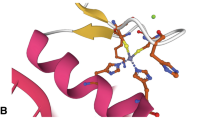Abstract
There are certain advantageous properties of metal ions both in their binding strengths and their rates of exchange of ligands which make them a potential source of chemically and hence biologically interesting selective properties. Zinc is the case in point here. Its most obvious distinction is its highly concentrated charge, Zn2+. It is also a small ion, radius 0.65 Å. In itself, however, an electrostatic charge of two and small size gives quite modest binding even to anions such as carboxylate and phosphate and even where several anions occur together. This is due to competition from water of hydration. Furthermore the electrostatic binding by zinc is a property shared almost equally with Mg2+ and, to a lesser degree, Ca2+ as well as with other metal cations such as Cu2+ and Ni2+, but it is not strong amongst organic ions. Thus although this part of its chemistry is special to metal ions it is not peculiar to zinc.
Access this chapter
Tax calculation will be finalised at checkout
Purchases are for personal use only
Preview
Unable to display preview. Download preview PDF.
Similar content being viewed by others
References
Berg J (1986) Potential metal-binding domains in nucleic acid binding proteins. Science 252: 485–493
Bertini I, Luchinat C, Maret W, Zeppezaner M (eds) (1986) Zinc enzymes. Progress in biochemistry and biophysics, vol 1. Berkhauser, Basle
Bruland KW (1983) Trace elements in sea water. In: Riley JP, Chester R (eds) Chemical oceanography, vol 8. Academic Press, London, pp 84–96
Giedroc DP, Keating KM, Martin CT, Williams KR, Coleman JE (1986) Zinc metalloproteins involved in replication and transcription. J Inorg Biochem 28: 155–169
Klug A, Rhodes D (1987) Zinc fingers. Trends Biochem Sci 12: 464–469
Siegel H (ed) (1983) Zinc and its role in biology and nutrition; metal ions in biological systems, vol 15. Dekker, New York
Spiro TG (ed) (1983) Zinc enzymes; metal ions in biology, vol 5. Wiley, New York
Williams RJP (1987) The functions of structure and dynamics in proteins, peptides and metal ion complexes. Carlsberg Res Comm 52: 1–30
Editor information
Editors and Affiliations
Rights and permissions
Copyright information
© 1989 Springer-Verlag Berlin Heidelberg
About this chapter
Cite this chapter
Williams, R.J.P. (1989). An Introduction to the Biochemistry of Zinc. In: Mills, C.F. (eds) Zinc in Human Biology. ILSI Human Nutrition Reviews. Springer, London. https://doi.org/10.1007/978-1-4471-3879-2_2
Download citation
DOI: https://doi.org/10.1007/978-1-4471-3879-2_2
Publisher Name: Springer, London
Print ISBN: 978-1-4471-3881-5
Online ISBN: 978-1-4471-3879-2
eBook Packages: Springer Book Archive




